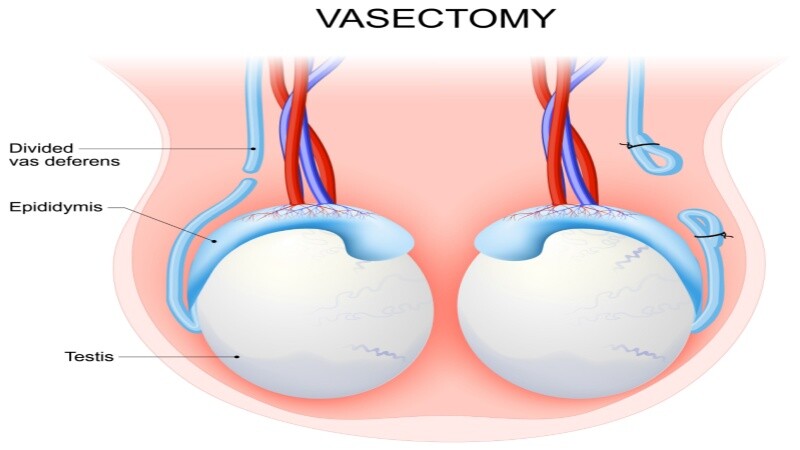
A lot of couples these days are showing their inclination towards vasectomy as a way of birth control. This procedure is a replica of tubal ligation in women, where the Fallopian tubes are tied off to prevent unwanted pregnancy. Moreover, vasectomy is considered one of the most full-proof procedures of birth control in men that leaves many men wondering if pregnancy is at all possible after it. And there are fewer chances of pregnancy after vasectomy.

What is a vasectomy?
How is a vasectomy done?
Step-by-step procedure for vasectomy
Chances of pregnancy after vasectomy
How women get pregnancy after vasectomy
Reasons for pregnancy after vasectomy
Can a pregnancy after vasectomy will be reversed?
What is a vasectomy?
A vasectomy is a form of the surgery that prevents pregnancy by blocking sperm from entering the semen. This is the birth control method that makes it permanently. It’s a quite common procedure, with doctors performing many surgeries throughout every year around the world.
The surgery involves cutting and sealing off the vas deferens. There are two tubes that carry sperm from the testicles to the urethra. Through this surgery, these tubes are closes then sperm cannot reach the semen.
The body produces sperm continues, but sperm reabsorb by the body again. When someone with a vasectomy ejaculates, then the fluid contains semen, but no sperm in it.
The vasectomy method is one of the effective birth control methods available in recent days. But there is still a very little bit of chance that this method won’t work, which could result in the pregnancy. Even if a vasectomy process is completely effective, it can take some time for this process to start protecting against pregnancy. There may still be some sperm in your semen for a few weeks after surgery is done.
How is a vasectomy done?
If anyone opts for a vasectomy, then he must go through a minor surgery that involves severing, cutting, sealing, or clamping of vas deferens from both the testicles. This severing of vas deferens prevents the sperms from mixing with the semen that gets ejaculated from the men’s penis. Hence, even after coming in contact with a woman, this semen without sperm cannot fertilize an egg.
However, the testicles continue to produce sperms, but these sperms are reabsorbed by the body. Since the tubes are blocked right before the seminal vesicles and prostate, one continues to ejaculate the same amount of liquid, the only difference being that this time the liquid is sperm-less, thus no chance of pregnancy after vasectomy.
Step-by-step procedure for vasectomy:
- Firstly, the area around one’s scrotum and testicles are nicely cleaned with the help of an antiseptic.
- After this, oral medicine is given to reduce anxiety and make the person sleepy, because of which he doesn’t remember much about the procedure.
- Anesthesia is injected in each of the vas deferens.
- After the fulfillment of these pre-surgery requirements, the specialist will make one or two small openings on the scrotum. The surgical instrument is passed through these openings, and vas deferens tubes are severed. After this, the vas deferens cut portions are tied, sealed or stitched.
- Finally, the vas deferens is placed back, and scrotum skin is stitched once again. These scrotum stitches usually dissolve over time and do not need any surgical removal.
- This surgery usually does not take more than 20 to 30 minutes and can be done by any experienced doctor.
No scalpel vasectomy:
This is another variant of the age-old procedure of vasectomy. And this includes poking of a clamp inside the scrotum skin and directly cutting off the vas deferens tubes. This procedure is as effective as traditional vasectomy. The brighter side of this procedure is that it includes less bleeding, smaller hole in the scrotum skin, and much fewer complications.
Chances of pregnancy after vasectomy
Usually, men who opt for vasectomy are certain that they never want to father a child ever again. As its success rate is 1/1000 after one year and 6-10/1000 after 5 Years. However, it is always better to have an analysis of the semen sample after a vasectomy to be totally sure about the success of the procedure.

Furthermore, there have been cases where the tubes grow back together and ejaculate sperms, just like pre-vasectomy.
Therefore, even though the chances of pregnancy after a vasectomy are slim, but it is there.
How women get pregnancy after vasectomy
As already mentioned, a vasectomy is a permanent way of achieving birth control. But just like women undergo tubal ligation reversal surgery, a man can also opt for vasectomy reversal surgery. Though the chances of making pregnancy after vasectomy reversal surgery are lesser than before, it still opens up the possibility of impregnating women.
Moreover, one must remember that after the vasectomy, it takes several months for the sperms to get fully reabsorbed or ejaculated. And until then, one must continue using other methods of birth control during sex, or else there are high chances that one would end up getting their partner pregnant. Therefore, if the contraceptive is not used until the sperm count is confirmed to be zero, there are chances of women getting pregnant.
Reasons for pregnancy after vasectomy:
Having sex too soon
Vasectomy process failures are most common in the months following surgery due to a couple engages in sex too early without using any contraception.
The 3 Months period is the life cycle of sperm. This means sperm may be able to get into semen for several months following this procedure. The longer the time gap since the vasectomy, the less time gap can chance to get pregnancy occurs.
Around 1–2 out of every 1,000 women have a get pregnancy after vasectomy surgery in a year.
The vasectomy process did not work
Sometimes the vasectomy process does not fully block the vas deferens in that cases get pregnancy after vasectomy. When this happens, a doctor might recommend doing the process again, sometimes using another vasectomy method also.
In many cases, a semen analysis that a doctor does after the procedure will reveal that it won’t work.
Recanalization
It is another reason for women getting pregnant after vasectomy. This is basically a natural reversal of vasectomy, where the sperms escape through the end of vas deferens due to some microscopic channels in scar tissues.
And lastly, surgical error, though the possibility of this also is rare pregnancy might occur if post-vasectomy semen analysis is not taken. Plus, find a skilled surgeon only to avoid any surgical error.
Can a pregnancy after vasectomy will be reversed?
Most vasectomy is reversible. Between 3–6% of males who have vasectomy eventually have a reversal.
The procedures of the reversal are:
- Vasovasostomy: This process is where a doctor rejoins the cut or clipped ends of the vas deferens. This process is used in many cases and is less technically challenging and has a high success rate in this procedure.
- Vasoepididymostomy: An alternative process is Vasoepididymostomy. In this method, a doctor joins one end of the vas deferens to the epididymis, and the tube stores sperm and transports it from the testes. This process is much technically challenging, and so has a low success rate in this procedure.
Final Talk:
There is no guarantee that a vasectomy procedure will work in all the people and chances to get pregnant after the vasectomy procedure. That a vasectomy reversal will make the person fertile. People should have the risks and benefits with their partners and doctors.

